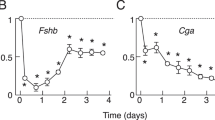Abstract
Gonadotropin-releasing hormone (GnRH) has been shown to play a role in the regulation of human chorionic gonadotropin (hCG) secretion by the human placenta. Molecular studies have demonstrated that human placental trophoblast cells synthesize a progonadotropin-releasing hormone (pro-GnRH) identical to its human hypothalamic counterpart. However, far less is known about nonhuman primates. To determine whether pro-GnRH exists in the rhesus placenta, pro-GnRH mRNA was cloned, sequenced, and shown to be 97.6% homologous to its human placental counterpart. A single base difference (base 1167) in the domain encoding GnRH results in the same amino acid, arginine, in position 8, whereas four base differences (bases 1200, 1253, 1268, 1292) in the domain encoding GnRH-associated peptide (GAP) result in four different amino acids in positions 19, 37, 42, and 50. The absence of a basic amino acid in position 50 suggests the rhesus sequence may be cleaved to yield GAP peptides different from the human placenta. Thus, these data justify the use of mammalian GnRH in studies of rhesus placental function, but indicate the need to investigate the roles unique GAP peptides may play in placental/uterine function.
Similar content being viewed by others
References
Khodr, G. and Siler-Khodr, T. M. (1978).Fert. Steril. 30, 301–304.
Haning, R. V. Jr., Choi, L., Kiggens, A. J., Kuzma, D. L., and Summerville, J. W. (1982).J. Clin. Endocrinol. Metab. 55, 213–218.
Belisle, S., Lehoux, J. G., Bellabarba, D., Gallo-Payet, N., and Guevin, J. F. (1987).Mol. Cell. Endocrinol. 49, 195–202.
Petraglia, G., Vaughan, J., and Vale, W. (1989).Proc. Natl. Acad. Sci. USA 86, 5114–5117.
Barnea, E. R., Feldman, D., Kaplan, M., and Morrish, D. W. (1990).J. Clin. Endocrinol. Metab. 71, 923–928.
Merz, W. E., Erlewein, C., Licht, P., and Harbarth, P. (1991).J. Clin. Endocrinol. Metab. 73, 84–92.
Currie, W. D., Steele, G. L., Yuen, B. H., Kordon, C., Gautron, J.-P., and Leung, P. C. K. (1992).Endocrinology 130, 2871–2876.
Yen, S. S. (1994).J. Reprod. Med. 39, 277–280.
Savoy-Moore, R. T., Schwartz, N. B., Duncan, J. A., and Marshall, J. C. (1980).Science 209, 942.
Currie, A. J., Fraser, H. M., and Sharpe, R. M. (1981).Biochem. Biophys. Res. Comm. 99, 332–338.
Khodr, G. S. and Siler-Khodr, T. (1978).Fert. Steril. 29, 523–526.
Miyake, A., Sakumoto, T., Aono, T., Kawamura, Y., Maeda, T., and Keiichi, K. (1982).Obstet. Gynecol. 60, 444–449.
Seppala, M., Wahlstrom, T., Lehtovirta, P., Lee, J. N., and Leppalouto, J. (1980).Clin. Endocrinol. 12, 441–451.
Petraglia, F., Woodruff, T. K., Botticelli, G., Botticelli, A., Genazzani, A. R., Mayo, K. E., and Vale, W. (1992).J. Clin. Endocrinol. Metab. 74, 1184–1188.
Duello, T. M., Tsai, S.-J., and Van Ess, P. J. (1992).Endocrinology 133, 2617–2623.
Seeburg, P. H. and Adelman, J. P. (1984).Nature 311, 666–668.
Kelly, A. C., Rodgers, A., Dong, K.-W., Barrezueta, N. X., Blum, M., and Roberts, J. L. (1991).DNA Cell Biol. 10, 411–421.
Seshagiri, P. B., Terasawa, E., and Hearn, J. P. (1994).Hum. Reprod. 9, 1300–1307.
Ronnekleiv, O. K., Naylor, B. R., Bond, C. T., and Adelman, J. P. (1989).Mol. Endocrinol. 3, 363–371.
Duello, T. M. and Boyle, T. A. (1996).Twenty-Ninth Annual Meeting of the Society for the Study of Reproduction. London, Ontario, Canada (abstract 223).
Adelman, J. P., Mason, A. J., Hayflick, J. S., and Seeburg, P. H. (1986).Proc. Natl. Acad. Sci. USA 83, 179–183.
Chirgwin, J. M., Przybyla, A. E., MacDonald, R. J., and Rutter, W. J. (1979).Biochemistry 18, 5294–5299.
Sambrook, J., Fritsch, E. F., and Maniatis, T. (1989). In:Molecular cloning—a laboratory manual. 2nd ed. Cold Spring Harbor Laboratory: Cold Spring Harbor, NY.
Author information
Authors and Affiliations
Corresponding author
Rights and permissions
About this article
Cite this article
Duello, T.M., Boyle, T.A. Placental progonadotropin-releasing hormone (Pro-GnRH) in the rhesus monkey. Endocr 6, 21–24 (1997). https://doi.org/10.1007/BF02738797
Received:
Revised:
Accepted:
Issue Date:
DOI: https://doi.org/10.1007/BF02738797




